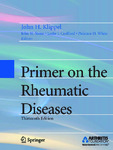| dc.description.abstract | Students, residents, and fellows interested in learning about the rheumatic diseases are faced with the daunting challenge of trying to integrate learning about a multitude of fascinating and diverse clinical disorders with an ever-expanding and complex body of basic science. This need encapsulates the principal rationale for the major changes in the 13th edition of The Primer on the Rheumatic Diseases. Although the first part of all recent editions of The Primer have summarized succinctly the physiology of tissues and cells that mediate inflammation and musculoskeletal disease, preparation of the new edition resulted in the identifi cation of two major problems with this “triedand-true” formula. First, for readers who really wished to understand the molecular basis of rheumatic disease to the depth that would facilitate laboratory research and improve patient care, the initial chapters no longer provided suffi cient detail. Second, for readers seeking an introduction or update within the clinical realm of rheumatic disorders, the fi rst part of The Primer bore virtually no relation to the diseases described so engagingly in the rest of the book. In short, in this era of increasing integration between the basic and clinical sciences, the preliminary Primer chapters were at risk for becoming simply the pages thumbed through quickly to get to the good stuff. Therefore, in the 13th edition, the clinical descriptions that The Primer has always done best have been augmented by including the clinically relevant basic science components in the same sections. Thus, for each major rheumatic disease— for example, rheumatoid arthritis, osteoarthritis, systemic lupus erythematosus, and idiopathic infl ammatory myopathies—the chapter describing the clinical and epidemiological features is accompanied by another chapter devoted to “Pathology and Pathogenesis.” This second chapter incorporates the appropriate (and updated) elements from previous Primer chapters entitled “Synovium,” “Articular Cartilage,” “The Complement System,” and “Muscle” that are essential to understanding a particular disease today. Moreover, this fundamental change in the contents is only the beginning of the improvements to the 13th edition. Other changes include:
• New chapters on “Clinical Immunology” and “Applied Genetics” designed to heighten the translational nature of the book. • Color fi gures that are particularly important for depicting cutaneous fi ndings and histopathology. • An expanded chapter on the cutaneous manifestations of disease, emphasizing the types of disorders rheumatologists often see in consultation. • A section devoted entirely to juvenile infl ammatory arthritis, with individual chapters on “Clinical Features,” “Pathology and Pathogenesis,” “Treatment and Assessment,” and “Special Considerations.” • Separate chapters on ankylosing spondylitis and the reactive and enteropathic arthropathies, once lumped together (with psoriatic arthritis) as “seronegative spondyloarthopathies.”
A tripling of the text devoted to psoriatic arthritis, an acknowledgement of the substantial treatment advances in that disorder. • Individual chapters (and more than doubling of the text) to the metabolic and infl ammatory myopathies, once included in the same chapter. • Reorganization of the vasculitis section along more rational and all-inclusive lines, with a chapter entitled “ANCA-Associated Vasculitis” that addresses together Wegener’s granulomatosis, microscopic polyangiitis, and the ChurgStrauss syndrome, disorders with striking similarities but important contrasts. • Now entering its eighth decade, The Primer has rejected strongly the notion that “If it ain’t broke, don’t fi x it.” In view of the recent remarkable strides in understanding and treating rheumatic disease, students, trainees, and practicing clinicians all need a standard textbook that can change with the times and reflect these advances. The Primer continues to fi ll that need. Read, learn, and enjoy. | en_US |

